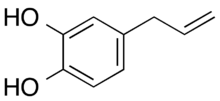Chemistry:Hydroxychavicol
From HandWiki

| |
| Names | |
|---|---|
| Preferred IUPAC name
4-(Prop-2-en-1-yl)benzene-1,2-diol | |
Other names
| |
| Identifiers | |
3D model (JSmol)
|
|
| ChEMBL | |
| ChemSpider | |
| EC Number |
|
PubChem CID
|
|
| UNII | |
| |
| |
| Properties | |
| C9H10O2 | |
| Molar mass | 150.177 g·mol−1 |
| Hazards | |
| GHS pictograms | 
|
| GHS Signal word | Warning |
| H302, H312, H315, H319 | |
| P264, P270, P280, P301+312, P302+352, P305+351+338, P312, P321, P322, P330, P332+313, P337+313, P362, P363, P501 | |
Except where otherwise noted, data are given for materials in their standard state (at 25 °C [77 °F], 100 kPa). | |
| Infobox references | |
Hydroxychavicol is a phenylpropanoid compound present in leaves of Piper betle.[1] It is a more potent inhibitor of xanthine oxidase (IC50=16.7 µM) than allopurinol.[2][3]
Research
It might be a useful new compound in treating cutaneous fungal infections.[4] It is a promising agent in prevention and treatment of dental disorders as it had bactericidal and fungicidal effect on Streptococcus intermedius, Streptococcus mutans, and Candida albicans and inhibited biofilm formation.[5][6][7][8]
See also
References
- ↑ "The new ether derivative of phenylpropanoid and bioactivity was investigated from the leaves of Piper betle L". Natural Product Research 34 (5): 638–645. March 2020. doi:10.1080/14786419.2018.1495634. PMID 30169967. https://figshare.com/articles/journal_contribution/7037525.
- ↑ "Hydroxychavicol: a potent xanthine oxidase inhibitor obtained from the leaves of betel, Piper betle". Journal of Natural Medicines 63 (3): 355–9. July 2009. doi:10.1007/s11418-009-0331-y. PMID 19387769.
- ↑ "Structure-Activity Relationships and Docking Studies of Hydroxychavicol and Its Analogs as Xanthine Oxidase Inhibitors". Chemical & Pharmaceutical Bulletin 66 (7): 741–747. July 2018. doi:10.1248/cpb.c18-00197. PMID 29695658.
- ↑ "Hydroxychavicol: A phytochemical targeting cutaneous fungal infections". Scientific Reports 6: 37867. November 2016. doi:10.1038/srep37867. PMID 27897199. Bibcode: 2016NatSR...637867A.
- ↑ "Comparative inhibitory effects of 4-allylpyrocatechol isolated from Piper betle on Streptococcus intermedius, Streptococcus mutans, and Candida albicans". Archives of Oral Biology 113: 104690. May 2020. doi:10.1016/j.archoralbio.2020.104690. PMID 32155466.
- ↑ Ali, Intzar; Khan, Farrah G; Suri, Krishan A; Gupta, Bishan D; Satti, Naresh K; Dutt, Prabhu; Afrin, Farhat; Qazi, Ghulam N et al. (2010). "In vitro antifungal activity of hydroxychavicol isolated from Piper betle L". Annals of Clinical Microbiology and Antimicrobials 9 (1): 7. doi:10.1186/1476-0711-9-7. ISSN 1476-0711. PMID 20128889.
- ↑ Himratul-Aznita, Wan Harun; Nor-Zulaila, Che Omran; Nurul-Fatihah, Khairuddin (2016). "Antifungal activity of dual combination of hydroxychavicol with commercialized agents against oral Candida species". SpringerPlus 5 (1): 1696. doi:10.1186/s40064-016-3396-6. ISSN 2193-1801. PMID 27757368.
- ↑ Mail, Mohd Hafiz; Himratul-Aznita, Wan Harun; Musa, Md Yusoff (2017). "Anti-hyphal properties of potential bioactive compounds for oral rinse in suppression of Candida growth". Biotechnology & Biotechnological Equipment 31 (5): 989–999. doi:10.1080/13102818.2017.1348255. ISSN 1310-2818.
 |

